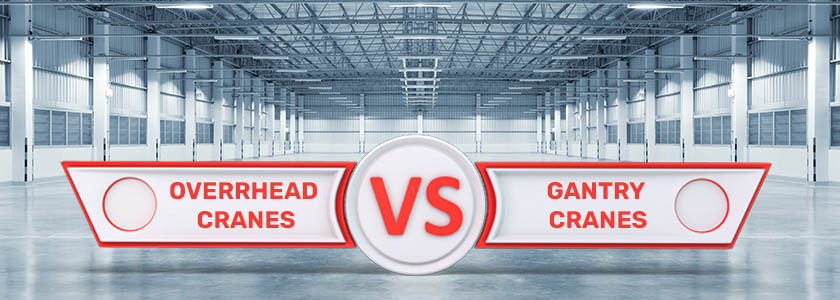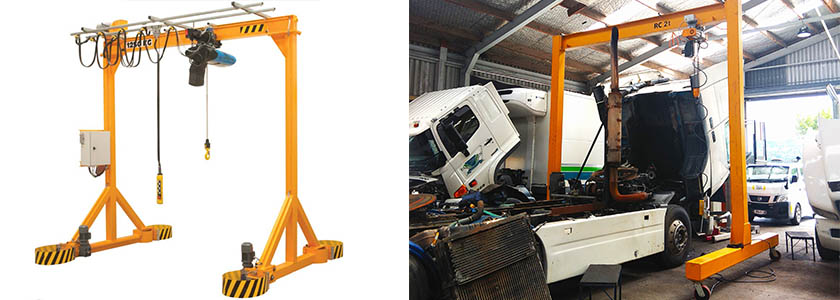It’s a question we hear a lot at Stratalign, and we can understand why. These two types of cranes are quite similar to the point that they can be interchangeable in some situations.
But for every similarity that overhead and gantry cranes share, there’s also a significant difference. There is a wealth of situations in which a gantry crane will be capable of a lift and an overhead crane won’t be, and vice versa.
So, what are the differences between these two cranes? While we’re at it, what are the similarities that these two cranes share? And in which situations would I pick each one? Read on to find out the answers to these questions and more.
Overhead crane vs gantry crane: the basics
Let’s begin by offering a quick definition of each of these cranes.
- Overhead cranes, sometimes called bridge or girder cranes, are usually attached to a building’s interior structure – often the girders that support the roof and walls. Strong steel tracks are permanently attached to the building girders, creating a framework that makes overhead cranes extremely strong and powerful, capable of lifting very heavy loads. The bridge will move along the mounted tracks.
- Gantry cranes, meanwhile, are self-contained and self-sufficient pieces of lifting equipment. Rather than permanently attaching to the structure of a building, the bridge is fixed to portable A-frame support legs, which often feature heavy-duty castor wheels to make the crane easy to move into any position within the building.
Gantry crane vs overhead crane differences
Now that we have an idea of the look of a bridge crane vs gantry crane, what are the main differences between the two?
Installation
As a permanent and particularly heavy duty piece of lifting equipment, the installation of an overhead crane can be rather time-consuming and complex. You will need to consult with professionals, particularly engineers, to ensure that the crane will be capable of lifting what you need it to lift where you need to lift it, and that the building will be able to cope with the stresses and strains caused by the crane.
As self-contained pieces of equipment, many gantry cranes don’t need to be installed so much as assembled. Some are anchored to the ground, while others are bought as mobile pieces of equipment, using wheels or tracks to move from A to B. Lighter, more mobile gantry cranes also tend to be easier to assemble and disassemble.
Lifting capacity
Overhead cranes are some of the most heavy-duty pieces of lifting equipment available, and are designed to lift extremely heavy loads. No matter what you might need to lift, a bridge crane will more than likely be capable of lifting it. This also extends to particularly large and unwieldy loads – because overhead cranes attach to the building itself, there are no feet or supporting columns for the load to collide with.
While gantry cranes can be capable of lifting heavy loads, they won’t have the capacity of an overhead crane on a like-for-like basis. The A frame may also represent a collision risk on a gantry crane vs a bridge crane.
Mobility
One area of superior performance for a gantry crane vs bridge overhead crane is mobility. While gantry cranes can be permanent features when anchored to the ground, they can also be perfectly mobile. Some varieties are small, light and easy to assemble and disassemble, making them ideal for businesses that travel from site to site. They can also feature wheels or be attached to tracks, allowing an operator to pick up a load in one area of a warehouse or factory and transport it to another.
Overhead cranes are immobile. They are permanently attached to the structure of a building, and are designed for repeated lifts within a specific area.
Cost
As heavy duty, permanent features that can be complex to install, you’ll generally spend more on a bridge crane vs a gantry crane. For the price you will get a piece of equipment that is capable of lifting heavier loads and that is designed to last a very long time.
Gantry crane vs overhead crane similarities
While they have their differences, overhead cranes and gantry cranes share a lot in common too. A few of the most notable similarities include:
Basic structure
Both a gantry crane and an overhead crane share the same basic structure: upright columns support a horizontal beam fitted with a trolley that rolls along its length. Squint your eyes at a picture of an overhead crane and a gantry crane and you might struggle to tell them apart.
The hoist
Both a gantry crane and an overhead crane feature a hoist. As this is the part of the crane that does the actual lifting, it has as much impact on the working load limit (WLL) of your crane than any other part.
Function and movement
On both types of crane the hoist is fitted to a trolley which rolls along the beam. This means that the movement and general function of gantry and overhead cranes are more or less the same – the differences are a function of where they’re installed, how they’re installed, and the loads each crane is capable of lifting and shifting.
Operation
Just as the movement and function is the same, so too is the operation of each type of crane. If you can operate a gantry crane, you can more than likely operate an overhead crane, and vice versa.
Do I need a gantry crane or overhead crane?
Now that we know the differences and similarities of overhead cranes vs gantry cranes, which is right for you? Here are a few factors that you should consider when choosing between the two.
Strength
What are you lifting? If it is something particularly heavy or awkward, is a gantry crane even an option? Consider the size and weight of the items you’ll be lifting, and how frequently you’ll be lifting them, to understand how heavy duty you’ll need your crane’s working load limit and service class to be.
Portability
Are you looking to do repeat lifts in one location, or do you need a crane that can move around your space, or even be transported to another location? If portability is a concern, a gantry crane will be the far better option.
Mounting options
Is your building capable of housing an overhead crane where you need one? Identify where you’ll be making your lifts, then get a structural engineer to check whether there are girders that will be up to the task of supporting a crane in your chosen location.
Budget
How much money do you have to spend on a crane? While gantry cranes tend to be more affordable than overhead cranes, this is largely because they aren’t permanent installations nor as heavy duty. Your budget will be a more significant consideration if both types of crane are an equally viable option.
Enabling New Zealand businesses to work smarter, quicker and safer
It’s safe to say that there’s a lot to consider when shopping for a crane. Understanding the terminology is one thing, securing the perfect piece of lifting equipment for your situation is quite another.
But if you do manage to choose the right crane option, you’ll give your business the opportunity to work more safely, more efficiently and more productively. That’s where we come in.
At Stratalign we’ve spent years helping Kiwi businesses identify and secure the lifting equipment that will get them working smarter, faster and safer. If you’re looking to enhance your operations with an overhead or gantry crane that does exactly what you need it to do, we’re ready to help.
Get in touch with our expert team today for a no-obligation consultation and quote.




